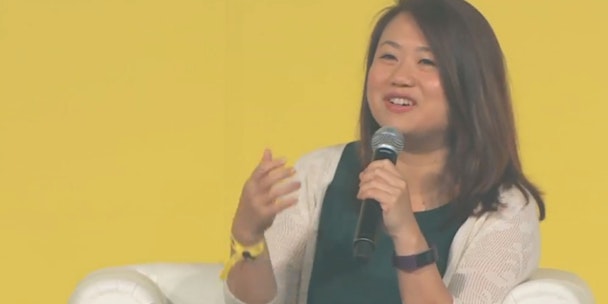'We are bigger now and we deserve to be scrutinised’: Grab’s Goh on buying out Uber in Southeast Asia
When news emerged that American ride-hailing giant Uber was planning to sell its business in Southeast Asia to Singapore-based ride-hailing firm Grab, it sent a seismic wave rippling through the region.

Grab's Cheryl Goh discusses the company's deal with Uber at the Tech In Asia conference.
As Grab negotiated with Uber away from the public eye, internally, none of its staff could believe that the deal was happening. However, they kept their trust in their co-founder and chief executive officer Anthony Tan.
This is according to Cheryl Goh, vice president of marketing at Grab, who was speaking on stage during a panel on day two of Tech in Asia 2018 Singapore conference. It is the first time a top executive from the company has spoken publicly on the deal making process since it became official.
“It was hard to imagine because if you look at Grab, we operate in southeast Asia, we are not necessarily big, compared to large start-ups in China or United States, where it is easy,” Goh told co-working space Found co-founder and panel moderator Grace Sai.
“I had quite a lot of questions, but we believed in Anthony's vision and by then, we were quite far along with the deal, so we trusted in his decisions and how he is taking us there. We thought that it was absolutely possible, and I think at that point, we also realised that after understanding it further, it was becoming a reality.”
Goh admitted that when Chinese ride-sharing giant Didi Chuxing bought out Uber’s operations in China, she was ‘nervous’ about the deal because Didi is an investor in Grab. However, she has since realised that the Didi-Uber deal set the precedence for Grab’s own buyout of Uber in SEA.
“Uber has left this region and we are buying parts of their business like their drivers, passengers and employees. We are taking over some of their offices, so it is pretty much a full acquisition where one party has left the country,” she explains. “Sometimes even we forget that how crazy that is - I remember when Didi bought Uber's business in China, I was quite nervous because they [Didi] were one of our investors. I was wondering what this meant at the point of time.”
“The reality is, it is a fantastic opportunity, which was what Anthony said at the point of time and he really valued this. He said ‘Guys, let's work really hard, let's focus on the customers, focus on the business. Because if you do that, then this could be an outcome for us‘.”
Explaining why it made sense for Grab to buy Uber, Goh said one thing that Grab always knew, but realised even better now, is that Uber is very much like Grab as they are passionate, believe in the same things and are driven by the same vision and mission.
“I guess when you are competing, you might not see that. But I think they are very much like Grab and as part of us onboarding them, we do take a lot of effort to roll out the red carpet. We try our best to welcome them by doing numerous townhalls and AMAs to help address any concerns they had,” said Goh. “It is still early days for us, but we remain positive and hopeful that this will be an easy transition because we are very similar in terms of age and demographics.”
When asked by Sai if there are any significant changes since the merger, Goh stressed that Grab now feels a great deal of responsibility post-merger to ensure a high-level of experience, service and platform standards.
“We have to own this because we are a bigger company now and we deserve to be scrutinised. We can be scrutinised because that is fair,” said Goh. “We always had competition all throughout our history and we have always pushed really hard. We might have, at certain point of our history, lacked superior technology but we worked very hard to treat our drivers better.”
While Goh avoided answering Sai‘s question on how Grab will deal with the potential entry of Indonesia ride-hailing firm Go-Jek into Singapore, she pointed out that competition remains ongoing in every market that Grab operates in, and there will always be options for people, which keeps the company sharp. “When you look at our largest growth, the most amount of change and improvements that we have done, it has always been in environment where there is someone for us to compete against,” explained Goh.
She added that while people still look at Grab as ride-hailing company, it considers itself more than that and the only way to move forward is looking at how are it is understanding and serving its customers better, as well as looking what changes the market.
“We are moving towards being more customer-focused, rather than competitor-focused. Our strength lies in the fact that we are a southeast Asian company,” said Goh. “There has been a lot of new apps that has launched since March and what makes SEA complex is that it takes a large operation scheme to understand how the region works. We have already done that in eight countries and 200 cities, so we will always welcome competition.
“We live in this region, so we are very committed to try and understand to be relevant. So whatever disadvantage that we may have had, we look at making up through being on the ground, through being local and by understanding the market a lot better.“
Goh previously spoke to The Drum in March before the Uber deal, about how Grab become a market leader in SEA.


